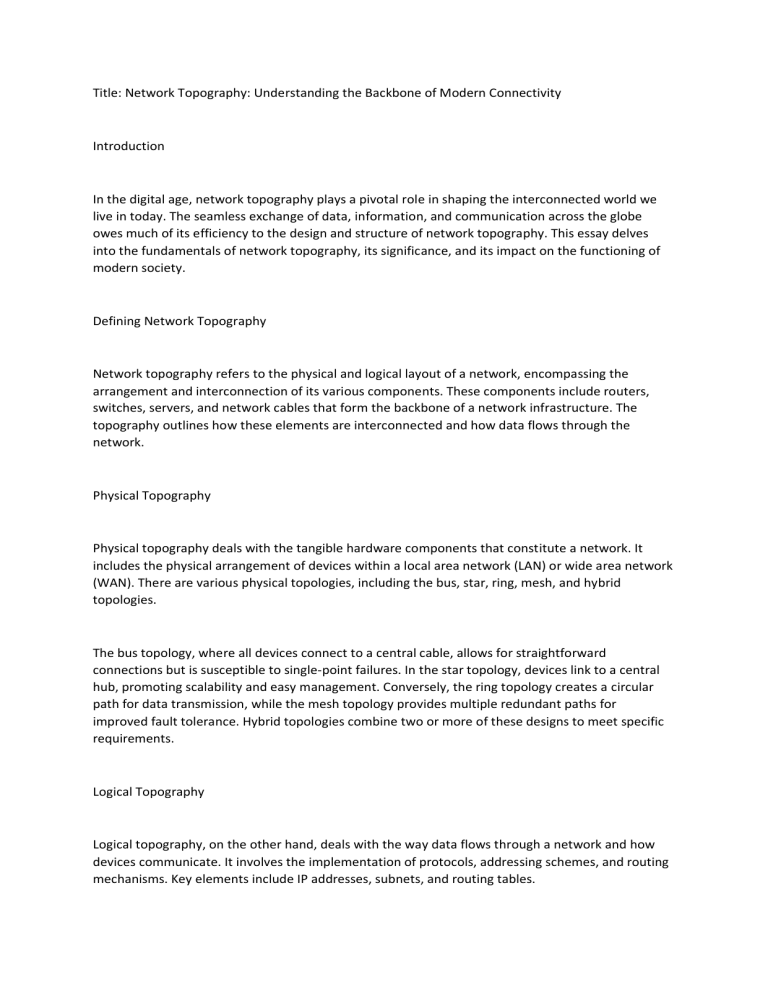
Title: Network Topography: Understanding the Backbone of Modern Connectivity Introduction In the digital age, network topography plays a pivotal role in shaping the interconnected world we live in today. The seamless exchange of data, information, and communication across the globe owes much of its efficiency to the design and structure of network topography. This essay delves into the fundamentals of network topography, its significance, and its impact on the functioning of modern society. Defining Network Topography Network topography refers to the physical and logical layout of a network, encompassing the arrangement and interconnection of its various components. These components include routers, switches, servers, and network cables that form the backbone of a network infrastructure. The topography outlines how these elements are interconnected and how data flows through the network. Physical Topography Physical topography deals with the tangible hardware components that constitute a network. It includes the physical arrangement of devices within a local area network (LAN) or wide area network (WAN). There are various physical topologies, including the bus, star, ring, mesh, and hybrid topologies. The bus topology, where all devices connect to a central cable, allows for straightforward connections but is susceptible to single-point failures. In the star topology, devices link to a central hub, promoting scalability and easy management. Conversely, the ring topology creates a circular path for data transmission, while the mesh topology provides multiple redundant paths for improved fault tolerance. Hybrid topologies combine two or more of these designs to meet specific requirements. Logical Topography Logical topography, on the other hand, deals with the way data flows through a network and how devices communicate. It involves the implementation of protocols, addressing schemes, and routing mechanisms. Key elements include IP addresses, subnets, and routing tables. The Role of Network Topography in Modern Connectivity Efficient Data Transmission: Network topography directly affects data transmission efficiency. An optimized topological layout minimizes latency and packet loss, facilitating fast and reliable data exchange. It ensures that data packets take the most direct route to their destination, reducing unnecessary hops and potential bottlenecks. Scalability: A well-designed network topography allows for seamless scalability as the network grows. Whether it is a LAN within a small office or a sprawling global WAN, scalability ensures that new devices and users can be added without compromising performance. Reliability and Redundancy: Network topologies with redundant paths provide fault tolerance. If one path fails, data can reroute through alternate routes, ensuring continuous connectivity. This aspect is particularly crucial for critical systems, such as emergency services, financial institutions, and healthcare facilities. Security and Isolation: Proper network topography aids in establishing security measures and segmenting sensitive data. Logical segmentation using VLANs (Virtual Local Area Networks) and firewalls helps isolate and protect specific parts of the network, mitigating the impact of potential security breaches. Cloud and Data Center Integration: With the rise of cloud computing and data centers, network topography becomes essential in linking on-premises infrastructure with cloud-based resources. The topological design must accommodate these hybrid environments to ensure seamless data flow. Impact on Modern Society The significance of network topography extends beyond technical implications, shaping modern society in various ways: 1. Communication: Network topography enables real-time communication, influencing how people interact, collaborate, and exchange information worldwide. 2. E-Commerce: The rise of online businesses and e-commerce platforms relies heavily on robust network topographies to handle vast amounts of transactions and data securely. 3. Social Media and Connectivity: Social media platforms heavily rely on network topography to support millions of users connecting, sharing, and exchanging information across the globe. 4. Remote Work: The COVID-19 pandemic accelerated the adoption of remote work, and network topography played a pivotal role in maintaining productivity and connectivity for remote workers. Conclusion Network topography remains the backbone of modern connectivity, facilitating seamless data exchange and communication. By combining efficient physical and logical designs, network administrators ensure optimized performance, scalability, and reliability. As technology continues to evolve, network topography will continue to adapt and shape the connected world in which we live. Understanding its fundamentals is crucial to navigating the complexities of the digital landscape and harnessing its vast potential for a better tomorrow.







